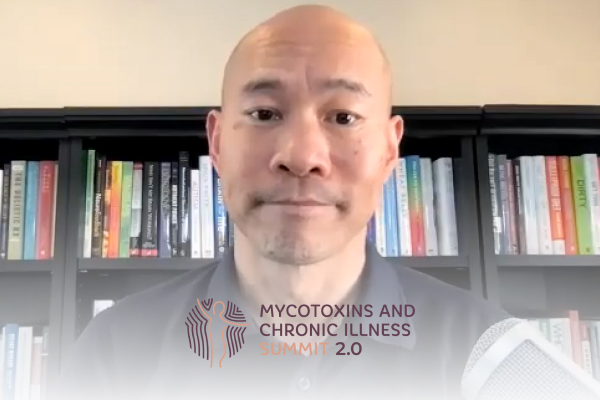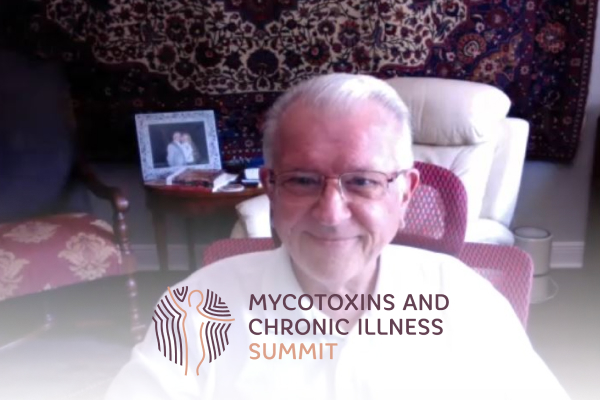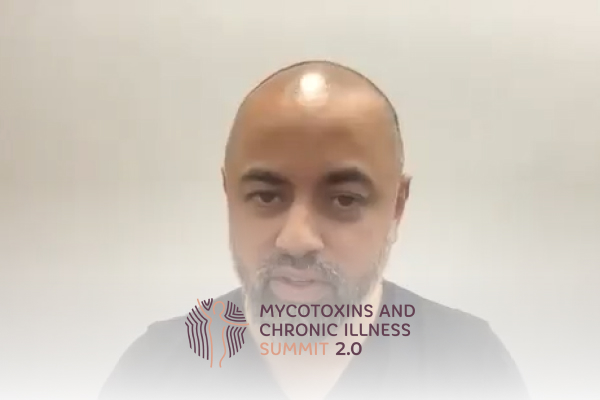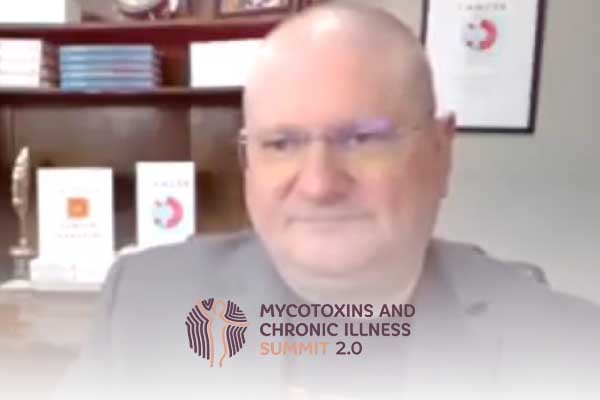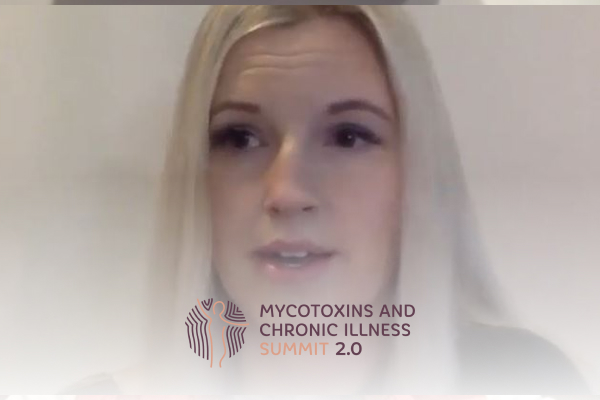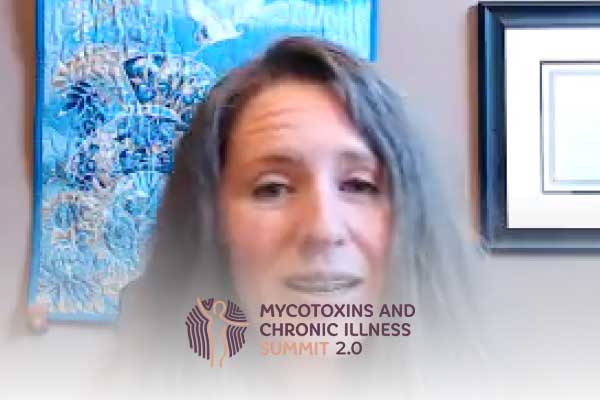Join the discussion below

Dr. Christine Schaffner is a board-certified Naturopathic Doctor who has helped thousands of people recover from chronic or complex illnesses. Through online summits, her Spectrum of Health podcast, network of Immanence Health clinics, and renowned online programs, Dr. Schaffner goes beyond biological medicine, pulling from all systems of medicine and... Read More

Peter Kan, DC, DACNB, FAAIM, CFMP, CGP
Dr. Kan supports and manages patients with chronic conditions using a comprehensive approach by merging the exciting advances of functional neurology and functional medicine. Dr. Kan is Board Certified in Integrative Medicine, Functional Medicine, and a Board Certified Chiropractic Neurologist. He is the creator of NeuroMetabolic Integration, a virtual functional... Read More
- How mycotoxins affects brain health and more specifically how it distrupts the blood brain barrier
- The lesser known neurodegenrative diseases associated with mycotoxins
- What you need to know about mycotoxins and immunity
Christine Schaffner, N.D.
Welcome everyone to the mycotoxin and chronic illness summit. I’m Dr. Christine Schaffner and today my guest is Dr. Peter Kan, and we’re gonna be talking about how mycotoxins affect your brain, immune and gut. welcome Dr. Kan it’s really fun to have you here.
Peter Kan, D.C.
It’s a pleasure to be speaking with you and to just bounce ideas off.
Christine Schaffner, N.D.
Yeah, no, I so enjoy getting to know you and for the listeners, Peter and I were just at a conference. And so this is a really fun to get to see each other again today and just talk shop. We have a lot of shared similarities and interests in how we approach patients and we see a lot of the same things. And so I’m always excited to hear what you’re doing and how I can also support all of you who are listening and getting better, cause I’m sure you’ve seen this Dr. Kan that, you know, mycotoxin is almost is on the rise, right? This is definitely a root cause of, you know, a lot of brain dysfunction and immune dysfunction, gut dysfunction. And so I know we have a lot to cover in this time and I know it will be really valuable for our audience. So why don’t we just dive in? So how do mycotoxins in your clinical perspective affect brain health?
Peter Kan, D.C.
Yeah, absolutely. Mycotoxin is definitely really inflammatory for brain and specifically mycotoxin can actually disrupt the blood brain barrier and there’s many studies that shows that mycotoxin actually can affect the astrocytes, which are the, the cells that maintain that blood brain barrier integrity. And when it does once your blood brain barrier becomes disrupted, then not only mycotoxins, but other things that are normally kept out of the brain can get through to the brain such as various chemicals and, and, and more notably actually your own immune cells. You know, the, the, the brain is considered an immune privileged site.
So what that means is, and normally it doesn’t really allow antibodies to get into the brain. When antibody does get into the brain, then potentially you can develop immune responses, autoimmune response to self brain tissue, because remember your brains always, you know, having normal cell turnover, you know, old brain cells die as the old brain cells die, then you get protein debris and these debris fields when exposed to antibody that are not normally there. You can develop neurological auto immunity and that becomes a source of inflammation. So, you know, knowing that mycotoxin can damage the blood brain barrier, it can be a potential way for you to develop neurological autoimmune, which becomes a problem because now your brain has antibody against, or your immune system antibody against brain that can create this persistent inflammation in the brain and inflammation in the brain can be felt as many of these symptoms that people usually feel in the brain, such as brain fog, fatigue, short term memory issues, difficulty concentrating, depression, anxiety.
So these are things that are very commonly seeing in doctor’s office. People go seek, you know, psychiatric care, you know, taking various medications for, but the root cause of that could be mycotoxin creating some type of neuro inflammation response. So mycotoxin is definitely very damaging to brain. And another way that mycotoxin caused problem with the brain is that, you know, the brain is very sensitive to any kind of inflammatory response. And, and so really, I, I always say that brain function requires three main things. Brain function or neurono function requires fuel and fuel comes in the form of oxygen and glucose. So people have to have steady fuel delivery. Brain function also depends on activation. So your neurons have to be constantly activated. It has to have neuro transmission and synaptic activity to keep itself in its own existence and maintain its own health and homeostasis. And then the third thing that rebrain requires is no inflammation. So when we have inflammation to neurons, neurons become very easily damaged.
They become unstable in their function. When neurons become unstable in their function, they can’t perform consistently. And people go through this state called trans neuro degeneration and trans neuro degeneration. The trans is not like transatlantic kind of trans, trans means like transient. So you get trans transient neurological issues, which means that your brain cell function becomes unstable. So your, your symptom comes and go kind of like a TIA, but not a TIA. You know, your brain fall comes and go. Your cognitive function comes and go. Your ability to concentrate comes and goes. So, so people would develop these neurological issues and, and becomes difficult to catch because it’s transient, right? So you go to your doctor, you go to neurologist and say, your MRI is fine.
Your cast scans fine. You don’t have a neurological problem, but yet you have these, transient neurological symptom that come and go, and this can be caused by mycotoxin exposure causing neurological degeneration. And as brain cells start to die off, they start to become unstable. So this can lead to a lot of just wide ranging symptoms that becomes very difficult to catch. And then lastly, you know, one of the main things is that mycotoxin really do a lot of damage, especially to your, your vestibular area. You know, your cerebellum can be hit. Your vestibular system can be hit and the vestibular system and your cerebellum controls your balance coordination, integration of eye movement to your cervical function. So people might get vertigo, dizziness, blurriness, not because of optical problem, but blurriness simply because of, you know, the, the inability for your vestibular ocular reflex to integrate.
So then your eye movement and your neck, movement’s not being coordinated properly. So people get these blurry visions simply because their eyes just not tracking properly. And so we see a lot of people with balance problems and, and, and these type of issues. And then we, we also can see that the mycotoxin can impact the peripheral nervous system. They can get like weird paraesthesia and on this tingling, that’s not a, dema tomo pattern. You know, it’s not like you have a pinched nerve, like the, the, the, the distribution of these paraesthesia does not add up. So that could also be caused by mycotoxin issue. So mycotoxin definitely is a big problem for, for brain cells and neurons. One of the key features is that brain cells are, you know, very fatty tissue.
Neurons contains a lot of fat, you know, the myelin sheath and the cell membrane so forth, and mycotoxin happened to be lipophilic. So they’re attracted to fats. So when you have mycotoxin in your body, they can easily migrate into fatty tissue in your brain. And therefore, cause actually cell membrane destruction. Lipid peroxidation, which leads to oxidative damage, which is all just word for inflammation. And then again, when your brain cells become inflamed, you lose that brain cell to brain cell conductance. So that nerve conduction velocity decreases from brain cell to brain cell. So then you have slower processing speed. People feel like, you know, it takes a long, the learning can go down, use able to retain information. Now you can’t retain information. So there’s a lot of problem that comes from mycotoxin that impact a neurological system. In fact, I always say the most common symptom are neurological symptoms when it comes to mycotoxin exposure.
Christine Schaffner, N.D.
Hmm, that was excellent. That was a really excellent overview of describing all those pathways that can be affected. And the, you know, all of those can be happening, you know, a lot in, in one patient, right. At different times, as you said. And so we can see the profound effect on the brain and the neurological system. And, you know, I we’re always, I know you and I are both looking at like underlying causes, right. And, you know, we both also look at these other infections and these other root causes of neuro inflammation, but the way that you described it, it, it, you know, it comes back to like the mycotoxin can be that opening the door to invite all of this other dysfunction on top of that.
And that’s why we see the complexity, you know, so no, that was really a great reminder for me. And, you know, I see all of that and, you know, one of the things, you know, if you’re struggling out there, you know, I think the scariest part of these symptoms is, I know, I’m sure your patients ask you this, Peter, like, you know, am I losing my brain as it can come back? And I do see when people heal from this, their brain is, you know, it’s totally able to be healed and these symptoms can resolve and you can have healthy, you know, cognitive function. But it it’s very, I think the scariest symptom for people going through this illness.
Peter Kan, D.C.
Yeah, absolutely. It can be. And especially because the symptom can overlap with other problems too, by the way. Right. So, so what I’m saying is not all brain fog and memory issue is caused by mold issues because there could be other reasons for the same symptom, but it’s definitely something you have to check off that box, make sure it’s not mycotoxin so.
Christine Schaffner, N.D.
Yeah. Great point. And I guess maybe for those who are listening, how can we really check that box and make sure that mycotoxins are not underlying the neurological dysfunction that somebody might be struggling with? How do you make sure that, that rule this in rule this out?
Peter Kan, D.C.
Yeah. And, and obviously there are tests for mycotoxin, right? So it’s several labs are offering to mycotoxin testing. So you can see what type of mycotoxin you have, which the purpose of that is not just to tell you whether you have mycotoxin, but to tell you, what type of mycotoxin, therefore, what type of mold you might be exposed to. Therefore you go look because, you know, people assume that all mycotoxin is because mold in your house, but certainly there’s a lot of these mycotoxin, that’s in your food source, you know, cereal, grains, corn, wheat, barley, and rice, these cereal grains, you know, the way they’re processed in store. A lot of time becomes very easily exposed to mold and they can start to, you know, develop these mycotoxins just from storage and you eat them.
Now you become, you know, accumulating these type of things. So, so I think people have to realize it’s not just from your house, having water damage. It can be food sources. And if you already have mycotoxin or you’re one who are sensitive, or even genetically predisposed, cause there’s genes that can predispose you to, you know, having more sensitivity or more reaction to mold, then you may want to consider, eliminate or reduce the consumption of those food that may be hide mold food, you know, like cereal grains and even coffee and, and things like that. So yeah. So we have to look at all sources and, and, and obviously history is really important, right? You ask, right. I, I think people become, and even doctors, you know, become over reliant on tests.
Nothing replaces a very thorough history and asking the right question to draw out cause that’s where all the, really, all the clinical paroles and really the clues to why someone is sick. And then you simply do the test to confirm your suspicion. I think a lot of people becomes just completely depend on a test and the test have no context whatsoever. I think that’s a problem. We have to learn how to be, you know, doctors have to be learn to be doctors and the patients have to learn to understand that a test, just one part of an overall assessment.
Christine Schaffner, N.D.
Hmm, great reminder. And I, again, it’s, you know, our job right, is to put all of this information test can be helpful, but they, they’re not a hundred percent and they’re not always the full picture. So no, that’s why, you know, find a great doctor who will listen to you out there, cause that’s a big part of our job, putting these glues together. So Peter, before we go on to immunity, I would love to hear maybe just some of your favorite solutions when you’re thinking about mycotoxins and helping the brain recover. Obviously there’s several mechanisms that you’re thinking about and you have to go through that and identify and make sure you’re treating the right thing, but you know, just maybe some of your favorites to share. So we can introduce people to some strategies that they can look into further.
Peter Kan, D.C.
Yeah, absolutely. And I always start with these type of exposure type of problems first with getting away from the exposure. Right? I mean, I mean you can take supplements, but if you’re still living in mold, I mean you can take supplements all day. You’re still living in mold, right. So we have to first get people away from that exposure. So it, it, the, the, the, the, the, the strategy may start with air purifiers. They start with dehumidifiers and, and things like that, or start with a mold test kit for your home and identify where the mold is coming from, if it’s from the home or from other source, as far as actual, you know, strategies, you know, so obviously you wanna do things to help, to bind to the mycotoxin.
So binders are useful here. And I usually use a combination of binders, I don’t use just use one. So, you know, we, I’ve been used activated charcoal and zeo like clay and bentonite clay in addition to humic and folic acid CLO you know, binders. So, so we’ll use a whole variety of different binders to really catch it all. So to speak really the, the damage caused by the mycotoxins really the inflammation, the oxydated damage that they cause. So I, I do a lot with just dampening that inflammatory process. So glutathione is just kind of goes without saying, because it’s kind of glutathione is like your bulletproof vest for your cells, right. It kind of protect your cells from the oxidated damage. And so if you have mycotoxin exposure, your level of oxidative damage may be higher than people who don’t have mole exposure. So giving you extra bulletproof vests would just protect your cells from becoming damaged and, and, and problematic. And, and by the way, some of these mold mycotoxin actually can inhibit glutathione production by blocking certain glutathione, you know, reductase and so forth. So that can actually shut down your glutathione production.
So taking glutathione is really, is really one of the key components for me, as far as helping people to minimize the damage. Caused by the mycotoxin while you’re trying to bind it, trying to eliminate it. And then, and then if it’s there’s neurological symptoms, then we obviously have to look at the, the brain. If there’s blood brain barrier issues, they can very well have brain inflammation caused by microglial activation. Then we may use flavanoid compounds things that can cross a blood brain barrier to help calm down that brain inflammation. This could be turmeric or glutathione is still useful.
Vitamin D is always helpful for barrier compromises. So those are starting points for me. And we may, we may even go deeper than that. But I think for most people, those are probably almost always helpful. Okay. Because I, I mean, I very few people don’t need, or don’t get help by glutathione. And, and in my experience, not very many people have reaction to it. Of course you have people who is always super sensitive that will react to everything, but for the most part, turmeric, resparatoral, glutathione, vitamin D most people do well. So for those of you listening, that’s probably a, a good place to start. And then the binders of course, you know, use different type of binder to help binding.
Christine Schaffner, N.D.
Awesome. That’s great info. And I’m just curious with your chiropractic background, do you feel like to, with those other things on board to really heal the vestibular system, do you feel like the chiropractic techniques that you’ve learned and your colleagues know are, you know, the best way to heal that? Or do you feel like just as long as you’re doing these other things, things line up to heal the cerebellum and the vestibular system?
Peter Kan, D.C.
Great question. Yeah, it really depends because you know, some people, they have a lot of cerebellar issue or vestibular problem, or, you know, appropriate set of issues to begin with, you know, and then if they already do, and then they get exposed to mycotoxins, then those weak area will become even more problematic. So maybe they were able to compensate for those vestibular issue and not be dizzy and not have problem. But now all of a sudden they get mycotoxin, boom. Now they’re dizzy. Now they have balance issues. Now they have vertigo or maybe they already have these problem brewing, so to speak. And so, and in one sense, if you have mycotoxin exposure, or if you are like acute, right. If you’re still living in an environment that has mold well, I mean, you could rehab the brain, but you know, your, your results gonna, your getting hit the ceiling as far as how, how much that rehab is gonna work for you because you’re still inflamed everyday by the, by the mold.
Christine Schaffner, N.D.
Right.
Peter Kan, D.C.
So we have to do a two prong approach. We have to both do that and activate the brain. Remember the brain neurons brain cells thrive with fuel sufficient fuel. So they can’t be, you know, if that’s oxygen and glucose. So know the way we, I look at oxygen is you can’t be anemic. You can’t have iron deficiency and anemia has many different form. You can be B12, anemic, you can be many different type of anemia. You, you can’t have low blood pressure or too high blood pressure also because that all gonna compromise perfusion to your brain and then glucose, you have to have steady glucose.
So hypoglycemia just as bad as insulin resistance. So I, I kind of look at, at the foundations first, make sure those are all working. Doesn’t mean like we don’t address the mold, but if somebody’s anemic and they have hypoglycemia and they have mold and you don’t get their blood sugar stable you don’t fix the anemia, it’s gonna be very difficult for them to feel better or get better from the mold or not as quick. Right. And as far as activation, remember, we said brain requires fuel and activation. This is where the activation part come. So, so what’s a chiropractic adjustment anyway? It’s activation of our receptor based system, right? Our nervous system is a receptor based mechanism, right? Sight, smell, touch, taste, it’s all environmental stimulus. And we have receptor that pick up sight, smell, touch, taste, just so happen.
Touch, especially joint proprioception, right movement is one of the biggest input into cerebellum because that’s what cerebellum do. Cerebellum does what it does is process propioceptive input. So that’s why adjustment work. However, you can definitely adjust someone incorrectly or present too much of a stimulus and overwhelm their nervous system. So that’s why sometimes people get adjusted. Whoa, I feel like way dizzy after adjustment, just cause maybe they just too much stimulus or adjust incorrectly. So this is where, you know, it gets a little more detailed and nuanced and you know, as board certified chiropractic neurologists, they they’re trying to, you know, identify the longitudinal level of the lesion and get really specific with the type of exercise or rehab you might do. So it may not be an adjustment. It may simply be eye exercises. It may simply be some type of cognitive visualization of your body moving in space stimulate a specific part of the brain. So again, it gets more details. That’s definitely not something I would just have anybody just do some stuff at home, have it assessed and then do very specific exercise for that.
Christine Schaffner, N.D.
Yeah. No thank you for sharing that. That was really wonderful. And what should people Google or look for? You know, what kind of training, just, I want people to know who to look for and make sure they go to the right people.
Peter Kan, D.C.
Yeah. The biggest organization that regulate, you know, and certify doctors who are trained in this type of practice is the American chiropractic neurology board.
Christine Schaffner, N.D.
Okay.
Peter Kan, D.C.
That’s the certifying body and the regulatory body for, for certified chiropractic neurologist. And we all have to, you know, take a very, you know, very difficult 300 hour course followed by a very difficult board exam to be certified. So people who usually go through the rigor of that training, you know, they, they have that ability to, you know, do this type of exam and, and recommend the proper type of therapies.
Christine Schaffner, N.D.
Thank you. I, I just wanted to hit that point, cause I’ve seen when I’ve had a, a physician like that on the team, it really can make things chill for the patient. It can be sometimes the missing piece. So that was a.
Peter Kan, D.C.
The team yeah, absolutely.
Christine Schaffner, N.D.
Yeah. Right. So I know this team that we have so great clinical pro there. All right. So Peter mycotoxins and immunity. So what do we need to know about that?
Peter Kan, D.C.
Yeah. mycotoxins cause definite problem with immune system function. Remember earlier I said about the blood brain barrier compromise and then the brain is a immune privileged site. So antibody doesn’t get through and if a gets through it can trigger autoimmunity in the brain. So that’s not just a brain problem, right? It’s also an immune system problem. It’s an immune system problem. That’s happening in the brain. So, you know, that’s why we can’t really separate it. That’s why, you know, I talk about the brain, the immune gut access, cause you can’t really separate the brain immune and the gut. They’re all working together. When someone has a brain gut disruption say, oh leaky gut leaky brain, like what’s what’s happening there. Well, it’s the cytokines that’s mediating that, right?
Because the cyto architecture of your intestinal lining with the zoning limb know clued in and a cloud ins is exactly the same structure as a blood brain barrier, which also has cloud ins and occludin and these in these proteins. So, when you have antibody against intestinal junction, protein of occludin and Zolin and Claudin these bodies circulate by blood and when it meets the blood brain barrier, it sees the same structure. So it’s like antibody, see the same thing that’s trying to attack, it’s attacking it. So this is the reason why leaky brain and leaky gut goes together and, and, and the mediator there is the cytokines, it’s the antibody, it’s the adaptive immunity. So we can’t really talk about all the things that I just talked about and that’s happening in the brain with the potential for leaky blood brain barrier, causing anti body to get through to the brain, picking up brain debris and developing self, you know, auto, reactive antibody to brain tissue.
That’s not just a brain problem. It’s an immune system problem as well. Now the problem is once you develop the antibody to brain, if you have a leaky blood brain barrier, that antibody can just leak back out from the brain into your circulation. So now it’s out of your brain. Now you just have circulating antibody, that’s floating around to brain tissue. And the cool thing is you can measure that, right? So there’s tests, you can measure antibody to these neurological tissues. And if you do, then that indicates, yep. That process is starting to happen. Now you may not have symptoms. That’s very severe or pronounced, but if you see antibody attacking brain tissue, you have to be concerned because that means that that reaction is already starting.
The, the, those nerve tissue are exposed to your immune system or your immune system exposed to nerve tissue, developing antibody. So if you let that process go and you don’t identify the online trigger, which could be mold right mycotoxin, or could be an infection or could be something that’s damaging brain, even concussion. This is why concussion’s a big deal. Cause you hit your head. Guess what you get, you get cellbrain debris, right? You get inflammation, your brain, the brain is getting sloshed around, getting hit. You’re gonna have some damaged brain tissue. And that can cause cytokines and Microglia activation that can actually trigger by the way, brain inflammation can trigger leaky blood brain barrier because all these inflammation happening, the brain triggers microglial activation and that inflammation in the brain can start to degrade the blood brain barrier.
And then that, that process started happening on the converse leaky blood brain barrier can also trigger microglial activation, which is brain inflammation. So they both cause each other to some degree. So, so what happens when you hit your head, your brain gets inflamed and that usually lend these leaky gut because all this inflammation in your brain is causing blood brain barrier disruption. And then, you know, these cytokines and potential blood brain tissue is leaking out now in your systemic circulation, you have immune cells attacking that, creating neural antibodies. And then not only that, that leaky blood brain barrier and antibody looks very similar to your gut barrier antibody.
So then you get the leaky gut, which we see this happening in, in animal models where you lesion the rats brain within hours, you see leaky gut happening. Epithelial cell started degrade. The Veli started degenerating within literally within hours of, you know, imparting a brain trauma in, in RA studies. So, so this process happened and it’s a systemic inflammatory issue. So really when you have brain inflammation, it’s not just, oh, leaky brain leaky gut. The way I see it is leaky brain leaky everything , your whole entire body becomes inflame. And when you have leaky gut, it’s not just leaky gut cause leaky brain. It’s when you have leaky gut, the whole entire body becomes inflame. So we have to see this as a brain immune gut access problem. And, and this is my whole, you know, point of making masterclass and teaching about is get people to appreciate that it’s all neuro degeneration.
Christine Schaffner, N.D.
Yeah.
Peter Kan, D.C.
So it’s not like, oh, you just have a brain problem, take some brain supplement or you just have leaky gut take a leaky gut supplement. You have to look at all of it, including looking at the triggers. That’s continuing to set fire to the system, which could be mycotoxins could be line, could be, can be the could be anything, right. Dietary, you know things, stress, even, you know, energetic imbalances perhaps, you know, that’s kind of where you come in, but definitely we have to kind of start seeing this as a whole, rather than a, oh, what do you do for the immune system then? Yes, but it’s really all of it. So.
Christine Schaffner, N.D.
Yeah, no, you’ve turned a great job describing that neuro degeneration and you know, I know people who are listening are, you know, taking that in as well. And you mentioned some really great, you know, markers and antibody markers to look at. And so do you have a favorite lab? Or you using Cyrex labs for this or any labs that people who are listening should go ask their doctor to get?
Peter Kan, D.C.
Yeah, two primary labs. Cyrex has a multiple autoimmune panel where it checks several of these neurological antibodies and then the vibrant America, vibrant wellness has a panel called neuro zoomer. And that that’s much more, even more detailed than the Cyrus labs checks for multiple neurological antibody. That’s the one that I use because it checks for so many different neurological antibodies, including blood brain marker that can indicate blood brain barrier disruption, marker that can indicate inflammation in the brain itself. Marker that can indicate problem with cerebellum, you know, you can still look at cerebellum antibodies, Perkin G cell antibodies look at peripheral nervous system antibodies.
So it’s not just CNS, but also peripheral nervous system. So it’s a really, really helpful test. I actually have a, a case where someone comes into me with the symptom where her, you know, she’s always squinting like this. You know, she feels tired, but she’s always squinting. She’s a nurse nighttime nurse night shift for many, many years. So I thought she was squinting because she’s just like her circadian rhythms messed up. She’s not sleeping. So she’s tired. And then turns out that when we did that, this neurological autoimmune test and this particular person we use vibrant, she had, you know, these markers against a neuromuscular junction against acetylcholine. And so that was a tip off to potentially that she may have myasthenia gravis.
Christine Schaffner, N.D.
Oh,
Peter Kan, D.C.
At the time she didn’t have that diagnosis. And you know, I was looking at her, and she’s like, whoa, she’s, you know, okay, she’s, she’s doing this. And literally a week after I got the test result and went over with her, she actually got diagnosed by her neurologist having Myasthenia gravis. She actually had a myasthenia gravis crisis where actually her lung shuts down, cause sometimes we have Myas gravis. It can actually shut down neuromuscular junction to your diaphragm. So she had like, she couldn’t breathe, had to go to the hospital emergency and you know, good thing she was okay. But literally this test preceded her actual crisis by like a week, you know So that was a case where that was predictive of an actual neurological autoimmune disease that was brewing already. So definitely it’s, it’s very helpful test. It’s not a diagnostic test in the medical sense because there’s people who have the same marker, but don’t have myas gravis, but it just tells you that that process brewing, we better start to be proactive with it.
Christine Schaffner, N.D.
Yeah, no, that’s a really, you know, amazing story and hopefully, you know, she’s, you know, on her way to healing. But now that I use the neuro Zoomer a lot too, I think that’s for all the reasons why you just shared. And it has also from my perspective too, I love how it shares like underlying infections too. Like especially the viral infections. That could be another piece of, you know, creating inflammation. So you get all of those perspectives. And so no, I think fibro is doing a great job up with having a lot of these tests that are really clinically useful and insightful, more affordable too for patients. So that’s great. That’s so I guess, I mean, I know that it’s probably all inter connected when we think about solutions, you know, for mycotoxins and immunity and you’ve already shared a bunch that I think would layer into this as well. But anything that you wanna highlight as far as a solution to think about when people are having these antibody responses or these immune, you know, like more autoimmune or inflammatory processes due to mycotoxins or other injections that you like.
Peter Kan, D.C.
Yeah, absolutely. You know, the, the way I, I think about it is that if we see neurological auto immunity on that neuro Zoomer test or any type of neurological antibody test, doesn’t have to be vibrant any other lab that does that. Then immediately I goes into the, I go into a mode where I’m not thinking about this as a brain problem. I’m thinking about it as an autoimmune problem and I’m treating it as such like, okay, you have an autoimmune process. Now I don’t say you have an autoimmune disease because you may have antibody, but don’t have disease yet, but the way we will manage it is we will manage it as an autoimmune problem. So how do you manage an autoimmune problem? Well, number one is to dampen that inflammatory response because people who are autoimmune automatically have more inflammation as, as a underlying process at baseline than people who don’t have autoimmune, right?
Because autoimmune equals inflammation cause cause your immune system is already, more inflammatory that way. So I treat it as an autoimmune problem, which means we want to dampen various inflammatory processes, dampen the NF CAPA B pathway, which is a comp final common pathway for inflammation response. We want to target perhaps TH one TH two and T regulatory cells to, to balance that, you know, if there’s any skew in, in immune function between TH one TH two and then lastly is look at really the, the game is play. The biggest difference that we can make is besides dampening that inflammatory response and calm down autoimmune look at triggers, you know, and I always say the inflammation is like the fire. You know your body’s on fire your brains on fire. You’ve got some fire. Yep. You’re on fire. You’re inflamed. Who’s the arsonist. Who’s setting the fire, right? Because you can put down the fire and you can take turmaric all day and put down the fire. But next day the fire starts all over again because you’re still exposed to that.
Mycotoxin you still have the, the viral infection. That’s not clearing. You still still have, you know, a, a, you know, sensitivity to gluten and you’re still eating gluten, whatever the example might be. So until we identify the actual arsonist and get that to stop, then you’re basically recreating the, the inflammatory source every day. Now some people, by the way, when they’re autoimmune, that’s the source. That’s the arsonist. When you are autoimmune, you already have an arson that’s built into your immune system, which is, which is sad, right? This is the difficulty of autoimmune it’s cause it’s your own body. How do you get rid of that? Right? You don’t wanna just, oh, the immune system is the problem autoimmune. Let’s get rid of the immune system. That’s the alopathic approach. They give you immune suppressants and this shut down whole thing. There’s a time and place for that. Right? Some people just, if it’s really acute, you need to do that. But long term it’s it’s about, you know, taking the, the, the immune stimulation, right? The triggers so that the immune system can come to its own resting place. And, and that requires a multimodal approach. You know, there’s not one supplement that does that. And there’s not one solution.
That’s the same for everybody with autoimmune. Cause some people have mold, some people don’t right. It’s kind of, it sounds like, like everybody has mold, not necessarily, or maybe some people have mold issues or they have Mycotoxin positive, but maybe that’s not their primary driver of their inflammation or their symptom. Maybe they have mold and virus in line, but it’s line, that’s really driving it. The mold’s kind of like just there, you know, like if we take a hundred people who’s completely asymptomatic. We did the mycotoxin test. I’m gonna bet we’re gonna see a bunch of people that have mycotoxin. And they’re, they’re just like, I don’t even know I have a problem. They feel just fine. So not a bunch. I don’t know. I, I don’t think that test has been done, but I’m gonna bet.
There’s probably some people that have mycotoxin, but they’re okay. The point is not that mycotoxin’s not important. It’s just that your body has way to compensate. And some people genetically tolerate it better. If you antioxidant capacity is really strong, you might be able to just handle it. Your immune, system’s not all screwed up so you can balance itself. But in people who are susceptible or have a lot of other stuff going on, plus stress plus EMF plus energetic imbalance, then mycotoxin could be a huge deal. You know? So we have to just go. That’s why requires a healthcare professional that understands this and people that kind of put it all kind of in a priority, right? Because you might go after all of it, you might choose not to. You might choose to go after the most important things first let the body heal.
So sometimes maybe there’s mold and line, but maybe the line is most problematic. You fix the line and then the mold problem becomes less problematic. And they’re not getting as much symptom from the mold because you fix the primary driver, which is a line. That’s just an example. But I really believe that there is a sequence to it and the sequence may not be the same for every single person. I do follow a general guideline. Right? I talked about if you’re anemic, probably it’s gonna be very difficult if your blood sugar sucks because you’re eating in such a way that feeds this up and down rollercoaster, blood sugar, cause that’s your dietary choice and not eat well, then it’s gonna be difficult for you to heal from, you know, mold and lime, even if you’re taking supplement for those. So always gotta do the foundations and then layer in those other things as well. But again, it’s a layering, so maybe there’s a specific sequence and I’m sure, you know, and, and that’s the art, right? So Doctor may have different ways to go about it. And as long as you’re getting people better, it’s all good.
Christine Schaffner, N.D.
Yeah.
Peter Kan, D.C.
It doesn’t have to be one way or another.
Christine Schaffner, N.D.
Yeah, yeah, no, I, I love how you keep on coming back to like, don’t ignore the low hanging fruit and the foundational things. Cause I think sometimes, you know, especially if people tried a lot of things and they go to a lot of doctors, sometimes we can think, oh, that’s been done or that’s been addressed. And sometimes yeah, the, these things are so important to lay the foundation for people to respond to treatment. So I, I think that’s a really good point. You keep coming back to so Peter microtoxins and gut health, you’ve weaved it a little bit in already, but I’m sure there’s more to say. So what would you like to add?
Peter Kan, D.C.
Yeah. So mycotoxin being basically a straight up poison, right? It’s basically poison produced by mold so it’s almost like the mold itself is really not the problem. It’s the mycotoxin, that’s the problem. It’s the poison produced by them. That’s causing the damage and the damage is an inflammatory one, right? Because it, it causes such a, a, it elicits a really strong immune response. You know, when your body sees mycotoxin, it freaks the heck out. And that inflammatory response itself, even though it’s trying to protect you, right, your body has soldiers that are trying to kill something. So sees mycotoxin, the ulicit that are strong response, even though it’s a natural immune response, but it comes with a price, this collateral damage associated with that strong inflammatory response.
So your body gets damaged and that damage is gonna lead to cytokines and systemic inflammation. But another thing that, that the, mycotoxin does, it, it kind of, it kind of shuts down mitochondrial function. So it impacts your mitochondria function. So then impacts your body ability to produce ATP. Then that, that further degrades your bodies, ability to heal and your gut lining. How does that impact the gut? Well, it’s as really the same thing. It’s basically, it’s not that you, you, you swallow some mold and then the mycotoxins they’re eating away your intestinal lining or the inflammatory things that’s happening. The immune system response that lead to this overactivation of immune function, that’s degrading to the gut lining that lead to the leaky gut. Now I will say this, that the microtoxin can actually just impact brain function in the way that we talked about earlier, when your brain becomes inflamed, by the way, your frequency of fire of your neurons tend to slow down. So right.
We know that the brain fires in frequency, that’s why you, the Q EEG were measuring the, the beta waste and so forth. So we know there’s a frequency. So the, the way neuron works is that for them to send signal from one neuron to another, through this electrical chemical transmission, which is your, you know, action potential, it happens in the frequency, right? And that frequency of fire can slow down in the face of inflammation. So when mycotoxin impact brain and cause inflammation that frequency of fire slows down either due to inflammation or lack of fuel or lack of activation. So when you’re inflamed, you may have hypo perfusion in specific region of your brain where you can get blood supplied to it. So then when that area of the brain not getting you enough blood flow, then everything just works slower. It’s almost like you have no gas in the tank. So the engine runs slow.
So then you’re not sending signals through as fast. When that frequency fire slows down in your cortex, it decreases the output of the cortex to your brainstem pantomegilary area, which is where your autonomic nervous system lives. And then one of the major outflow of that is your Vaus nerve. So everybody talk about Vaus nerve. Like that’s where it starts. No vagus nerve is a downstream thing above that is your cortex. So if you have a less than optimal function of your, cortex because the frequency of firing and integration of your brain is slower due to inflammation or fuel delivery problem. Then the output of that brain to stimulate the, the autonomic center, including your vagus nerve will be slow too. So people always say, how do I stimulate the vagus nerve, the vagus nerve, the vagus nerve?
Well, you might have to go above the vagus nerve because the flow comes from the top down. So we may have to get the cortex to work properly. So this is where, you know, and then if you have decreased vagus nerve, then your, your peristalsis, your gastric secretions go down bluff flow to the gut decrease. So then you don’t heal that lining as well. So there there’s your gut problem, right? Can be all due to the Vagus nerve issue. But I will say, that’s, you gotta go above the Vegas.
You gotta go through the cortex. And, and, and where, where do you go above the cortex? What actually loops back down is through the cerebelum the pro perception. So basically movement drives signal to your cerebellum, which pushes into your brain. So this is why we have to move, right? If you’re really sedentary, you sit there all day, your brain literally just degenerates over time, cause you require movement. Or if you have you’re stuck, right? Your joint is restricted. This is where a chiropractic, why chiropractor realized many, many hundred years ago that wow adjustment does something really magical because we restore motion or movement in a specific joint. And therefore your brain’s like, oh, now I’m getting nutrient from that joint, like a signal. So it can’t be missing signal.
So that’s part of it. But, but the point is that if there’s gut issue is gonna be mediated by remember the brain immune gut, right? We have to cytokines, we have this inflammation that’s systemic. And then we have the brain, not just in the blood brain barrier issue, the brain inflammation, but literally the actual neurology itself, how our cortex is able to fire to generate that outflow from the cortex into your brain stem and therefore the vagus nerve function. Therefore the gut.
Christine Schaffner, N.D.
Hmm, love that. Yeah, no, I feel like I’m getting a refresh in all my pathophysiology, so I really appreciate this. Yeah, no, I love it. And no, I think a really good point cause the Vegas nerve, there is again, so much awareness, which is awesome, but even people kind of can get a little bit myopic and not look at the big picture again or you know, all of these connections. So, and, and you know what, I, you know, what you’re weaving in, in your conversation too, which I appreciate is, you know, again, it is a team, right? And we know all of these things that we need to do within the body and in your treatment.
But you know, really people I, I find when you have a good structural physician or body worker or therapist on your team, I do, I feel like that really helps my patients move, you know, I’m in game momentum. So I you’re highlighting, you know, through this conversation. Why, so someone taking care of your spine and you’re dame to tissue and all of that. So I, I think it’s really important piece. So Peter, I guess any solutions or any other solutions related to, you know, this gut inflammatory kinda cycle that you wanna share as we wrap up?
Peter Kan, D.C.
Yeah. I, I, I think, I think that, that the biggest takeaway for me personally, how I manage people with mold is that I’m looking at not just the mold, I’m looking at the impact that the mycotoxin has on the brain immune gut. And obviously some people with mycotoxin exposure may have more brain presentation. And another person with the same mold exposure may have more gut presentation. So we have to customize each person and not just say, everybody’s brain a mean gut. Here’s a five things you take for every single person, but, but I’m always cognizant of, okay, I need to support the barrier. And that’s the gut barrier. That’s the blood brain barrier. And if they have respiratory issues, certainly if you have mold exposure and it’s, you know, environmental mold or black mold, and you have respiratory issues, then we may need to support the lung barrier as well. Right.
So, so we were looking at those and we’re always, I’m always keeping in front of, okay, how is this going to trigger a potential autoimmune problem? Because why don’t you trigger an autoimmune problem then turns into a different beast that is no longer just, oh, just leaky gut or not just, oh, you have some little brain fog. It’s okay. Do you have your immune system literally chewing your own body tissue? If so, we have to get that to stop because immune system’s job is to chew things up usually is chewing out the bad guys. But if it, if it deems your own body tissue to be the bad guy, it, it doesn’t stop until his job is done.
Christine Schaffner, N.D.
Right.
Peter Kan, D.C.
So done, meaning it’s gonna chew up, you know, whatever it sees and that’s not a good situation. So we’re always thinking about how do we protect the person from long term damages. And, and so I’m always keeping autoimmune at the forefront of my thought, as far as managing that. And when it comes to that, the tools are again, you know, stuff to help with gut barrier. And there’s, you know, being talked about, you know, alglutamin, and, and, you know, things that help with leaky gut and other things that in, you know, short chain, fatty acid and so forth. And then for the brain specifically, there’s things that can cross a blood brain barrier like turmeric and resparatoral, and then things that help just balance TH one TH two and support T regulatory cells that might be glutathione and vitamin D and, and then there’s other things that we can add to it depends on how the person presents.
So those, are the top things that I always think about as foundational tools, and obviously if there’s mycotoxin, then we wanna think about binders. How do we pull them out? And as we pull out the, the, the mycotoxin, how do we support these drainage processes? Make sure the person’s actually able to eliminate detoxification process working. So it, it, it gets even more than that. And do they also have other things going on viruses and so forth? And what do you decide? Which one to go after first? You know, because mold can be an immune suppressant, you know, it can suppress your immune system. So then even though you’re trying to fight something, but you can’t. So sometimes like, okay, do we fix the virus or the mold first? I mean, mold can hold up the virus. So your immune system can’t fight the virus, so we might go after the mold first. So, because I, I think mold is just, it’s so toxic. Right? It’s so it’s, it’s such a toxic thing, even in small amounts, it’s still really toxic so that it may be actually one of the top priorities.
Christine Schaffner, N.D.
Hmm, yeah, no, absolutely. And that’s a big, you know, goal for, you know, the summit is to, you know, highlight, you know, mycotoxins can be that as we say, kind of entry way that, you know, allows, you know, all of these opportunistic infections and, you know, really damages our detoxification pathways and disrupts all the barriers in the body of as you, so, you know, well informed us today. So, no, I mean, I, I think, you know, if anyone who’s listening out here, if you’ve been focused on maybe a piece of the puzzle and haven’t really ruled this out yet, I think Dr. Kan has given us a wealth of, of knowledge to really make sure that you rule this out, and this is not, you know, the missing piece to the puzzle to get you better. So, so Dr. Kan, how can people respirator with you? I know that you’re putting so much great education out there, so please share how people can respirator with you and your community.
Peter Kan, D.C.
Yeah, absolutely. I put out a lot of free content, you know, online, so you can go to my YouTube channel, just, you know, search on YouTube, Dr. Peter Kan. That’s K A N no H you’ll see the baldhead a Chinese guy, pretty hard to miss probably the only one talking about this, that baldhead and Chinese at the same time and this good and this good looking.
Christine Schaffner, N.D.
Yeah.
Peter Kan, D.C.
Not any worse looking and not any better looking just exactly this level of good looking, find me on YouTube. And then also we, I have my website ask Dr.kan.com and we also put out information masterclasses called the brain immune gut masterclass. It’s the B I G masterclass, where I talk about this brain immune gut access problem. So those are all free resources for people to, to look me up and learn from.
Christine Schaffner, N.D.
Great. Well, no, I so appreciate you sharing that, and I’ll just put a plugin. I know that you’re putting in so much free information, and then I know you’ve helped a lot of my community with your master class. So I’m so grateful that you put all of that information in one place. If people wanna go deeper, you clearly know what you’re talking about after our interview today. And it’s always a pleasure to connect and thank you so much for contributing to the summit.
Peter Kan, D.C.
Thank you for having me.
Downloads

